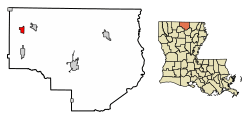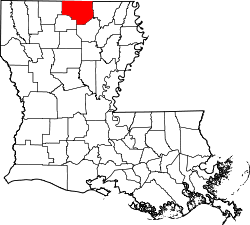Lillie, Louisiana
Lillie is a village in Union Parish, Louisiana, United States. The population was 118 at the 2010 census, a decrease from 139 in 2000. It is part of the Monroe Metropolitan Statistical Area.
Lillie, Louisiana | |
|---|---|
Village | |
| Village of Lillie | |
 Location of Lillie in Union Parish, Louisiana. | |
.svg.png) Location of Louisiana in the United States | |
| Coordinates: 32°55′13″N 92°39′42″W | |
| Country | United States |
| State | Louisiana |
| Parish | Union |
| Area | |
| • Total | 1.94 sq mi (5.02 km2) |
| • Land | 1.93 sq mi (5.00 km2) |
| • Water | 0.01 sq mi (0.03 km2) |
| Elevation | 121 ft (37 m) |
| Population (2010) | |
| • Total | 118 |
| • Estimate (2019)[2] | 120 |
| • Density | 62.21/sq mi (24.02/km2) |
| Time zone | UTC-6 (CST) |
| • Summer (DST) | UTC-5 (CDT) |
| Area code(s) | 318 |
| FIPS code | 22-43920 |
According to a 2007 report, Lillie was named one of the 10 worst speed traps in the state of Louisiana. Lillie made 85.59% of its revenue, an average of roughly $508 per capita population, from fines and forfeitures in the 2005 fiscal year.
Geography
Lillie is located at 32°55′13″N 92°39′42″W (32.920319, -92.661563).[3]
According to the United States Census Bureau, the village has a total area of 1.9 square miles (5.0 km2), of which 1.9 square miles (5.0 km2) is land and 0.04 square mile (0.1 km2) (1.03%) is water.
Demographics
| Historical population | |||
|---|---|---|---|
| Census | Pop. | %± | |
| 1970 | 160 | — | |
| 1980 | 172 | 7.5% | |
| 1990 | 145 | −15.7% | |
| 2000 | 139 | −4.1% | |
| 2010 | 118 | −15.1% | |
| Est. 2019 | 120 | [2] | 1.7% |
| U.S. Decennial Census[4] | |||
As of the census[5] of 2000, there were 139 people, 54 households, and 36 families residing in the village. The population density was 72.3 inhabitants per square mile (28.0/km2). There were 65 housing units at an average density of 33.8 per square mile (13.1/km2). The racial makeup of the village was 72.66% White, 23.74% African American, 2.88% from other races, and 0.72% from two or more races. Hispanic or Latino of any race were 4.32% of the population.
There were 54 households, out of which 25.9% had children under the age of 18 living with them, 53.7% were married couples living together, 13.0% had a female householder with no husband present, and 31.5% were non-families. 29.6% of all households were made up of individuals, and 20.4% had someone living alone who was 65 years of age or older. The average household size was 2.57 and the average family size was 3.24.
In the village, the population was spread out, with 20.9% under the age of 18, 13.7% from 18 to 24, 23.7% from 25 to 44, 24.5% from 45 to 64, and 17.3% who were 65 years of age or older. The median age was 39 years. For every 100 females, there were 98.6 males. For every 100 females age 18 and over, there were 100.0 males.
The median income for a household in the village was $29,167, and the median income for a family was $40,000. Males had a median income of $28,750 versus $21,250 for females. The per capita income for the village was $14,404. There were 5.0% of families and 10.6% of the population living below the poverty line, including 6.3% of under eighteens and 8.0% of those over 64.
References
- "2019 U.S. Gazetteer Files". United States Census Bureau. Retrieved July 25, 2020.
- "Population and Housing Unit Estimates". United States Census Bureau. May 24, 2020. Retrieved May 27, 2020.
- "US Gazetteer files: 2010, 2000, and 1990". United States Census Bureau. 2011-02-12. Retrieved 2011-04-23.
- "Census of Population and Housing". Census.gov. Retrieved June 4, 2015.
- "U.S. Census website". United States Census Bureau. Retrieved 2008-01-31.
External links
- Lillie Progress Community Progress Site for Lillie, Louisiana
